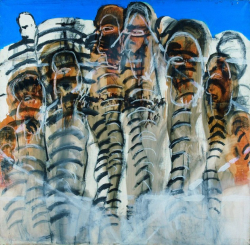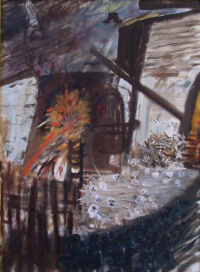Media
Exhibition: “Surviving Evil: The Pictorial Language of Sara Atzmon”
25 Feb 2014
To bring awareness to the Holocaust and educate the young generation to tolerate people with different ethnical and cultural background
The Hong Kong Holocaust and Tolerance Centre, the University Museum and Art Gallery and Goethe-Institut Hong Kong opens a major exhibition “Surviving Evil: The Pictorial Language of Sara Atzmon” today (25 February) in Hong Kong showcasing for the first time in the Greater China the artworks by Ms Sara Atzmon, a Shoah (Holocaust) survivor. Officiating guests of the opening ceremony include Ms Sara Atzmon; the Honourable Eddie Ng Hak-kim, Secretary for Education of the Hong Kong Special Administrative Region; Mrs Regina Ip Lau Suk-Yee, Principal of Savantas Liberal Arts Academy; Mr Nikolaus Graf Lambsdorff, the Consul General of the Federal Republic of Germany in Hong Kong; Mr. Sagi Karni, the Consul General of the State of Israel in Hong Kong; Mr Jeremy Amias, Chairman of the Hong Kong Holocaust and Tolerance Centre and Dr Florian Knothe, Director of the University Museum and Art Gallery, the University of Hong Kong.
Ms Atzmon, a Holocaust survivor, was born in Hungary and now resides in Israel. Her artworks, many of which are large-scale, highly impactful paintings, reflect the artist’s memories of her horrible experiences during the Shoah. In 1944, Ms Atzmon was first deported to Strasshof concentration camp and from there she was sent to Bergen-Belsen concentration camp under terrible circumstances.
As an adult, Ms Atzmon became a talent painter dedicated to use her, often very dramatic and explicit, paintings, to bring awareness to the cruel times in the fairly recent past, and to educate the young generation to treasure and practice tolerance, to foster understanding and compassion among people of different religion and cultural backgrounds.
Ms Atzmon was at the University of Hong Kong to officiate at the opening ceremony of her exhibition. She was invited to lecture at the University thus able to engage directly with the audiences in exchange of thoughts and knowledge. .
Details of the exhibition “Surviving Evil: The Pictorial Language of Sara Atzmon”
Period: February 26, 2014 (Wednesday) to May 4, 2014 (Sunday)
Opening Hours: 09:30 to 18:00 (Monday – Saturday); 13:00 – 18:00 (Sunday).
Closed on University and Public Holidays
Venue: 1/F, T.T. Tsui Building, University Museum and Art Gallery, The University of Hong Kong.
Tel: (852) 2241 5500 (General Enquiry)
Free Admission
For media enquiries, please contact:
Miss Elena Cheung (Communication Officer), Tel: (852) 2241 5512, Email: elenac@hku.hk
For details of the exhibition, please contact:
University Museum and Art Gallery, the University of Hong Kong, Tel: 2241 5500, Email: museum@hku.hk.
Details of public lectures and guided tours as well as the outreach programmes to schools will be announced soon.
Sara Atzmon’s biography
1933 Sara Atzmon, known as Sara Gottdiener before married to Uri Atzmon, was born the fourteenth of sixteen children in Hahdunanas, Hungary.
1940 With Fascism rising in Hungary, Jews were being persecuted, humiliated and killed. Sara’s father and four of Sara’s brothers were drafted to work at a forced labour camp.
1944 The Gottdiener family was taken to the Debrecen ghetto, where Jews surrendered all their valuables to the Gestapo and were forced to wear the Jewish Star of David.
Sara began a period of intense hardship and humiliation. At age 11, Sara was forced to undergo the fear and pain of a "gynecological" exam by the Nazis, who were looking for valuables allegedly hidden inside girls.
Jews were later taken from the Debrecen ghetto to a brick factory outside of the city. Here, 40,000 prisoners were only provided four water taps and four toilets. From there, transports of Jews to Auschwitz were organized.
On June 25, Sara was put in a cattle car with 95 other prisoners on a train to Auschwitz. The train was not listed to go on to Auschwitz and so the prisoners were not received into the camp. Instead, all were sent to a concentration camp in Strasshof, where Sara was forced to strip naked and be "disinfected" upon her arrival.
Sara and her family were soon sent on to a forced labour camp in Heidenreichstein, Austria, where she was forced to work from morning to night with only one slice of bread a day. On August 11, Sara’s father, weakened by hard labour and starvation, suffered a breakdown and died with Sara standing next to him.
The Gottdiener family was transported again to work in a parachute factory and then transported again later in November back to Strasshof, where they spent three days at a disinfection camp.
In early December, the family was loaded again into a cattle car and transported to the Bergen-Belsen concentration camp, where Sara witnessed the unimaginable. People were full of lice and there was hardly any food or water. Many people died of typhoid and many of those who did not were given a lethal injection by the SS shortly before the war ended.
Sara endured roll calls for hours on end in the freezing cold. In front of the windows of her barracks, "The Hungarian House", corpses were piled high in mounds.
1945 In early April, the SS organized transports filled with Jews to use in exchange for German prisoners of war. On April 6, Sara was put on such a transport leaving Bergen-Belsen; but the train was abandoned by the SS guards who were running from the advancing Allied troops.
On April 13, at Farsleben, American troops encountered the abandoned trains and Sara, aged 12 and weighing only 17 kilos, was freed. Thirteen of the sixteen Gottdiener children and their mother survived. Sixty other members of Sara’s family were murdered by the Nazis.
Sara was then brought back to the newly liberated concentration camp in Buchenwald where the Red Cross was organizing children's transports to America, Switzerland and Palestine. The Gottdiener family decided to go to Palestine and arrived, via Paris and Marseille, on the first immigration ship to Haifa, Palestine on 16 July 1945.
Although Sara and other children entered Palestine legally, she was again put into a camp, this time by British soldiers, for "illegal immigrants". Here she was again a prisoner, looking at barbed wire, being disinfected and facing separation from her family.
1949 After the Israeli War of Independence (1947–1949), Sara finally attended school and graduated from the seventh grade. She worked in various jobs and completed her education through evening courses.
1951-1953 Sara served in the Israeli Army.
1954 Sara married Uri Atzmon, who was born in Israel. Together they raised six children and twenty-two grandchildren. Sara did not speak of her past until nearly 20 years later.
1982 Sara began painting in a community group once a week. Her circle exhibited their works but even as she painted flowers and fruit, she was certain that this was merely preparation for her real destiny.
1980s Sara began to lecture about the Holocaust at schools. Despite some children’s emotional reactions, Sara felt that most students did not really comprehend what she taught and she feared that the Holocaust might be forgotten.
1987 Sara returned to Hungary, her country of birth, for the first time. She was outraged that many of her countrymen did not know what had happened to Hungarian Jews during the war. Upon her return to Israel, Sara began to paint the memories of the horrors she experienced in the Holocaust.
1990s Sara’s work is on permanent display at Yad Vashem, the Holocaust Museum and Centre for Holocaust Research, in Jerusalem, Israel. Sara also began to exhibit her work internationally. In 1993, she received the Sussman Prize from the Austrian government.
1997 Sara attended an international conference at the Memorial of the Holocaust in Brussels. Immediately afterwards, she arranged additional exhibitions in Jerusalem and at Tel Aviv University.
2000 An exhibition of Sara’s paintings was held at the Stockholm Historical Museum coinciding with an International Conference on Holocaust history.
2000s In recent years, more than ninety Holocaust-related exhibitions of Sara’s artworks have been held throughout Israel at high profile locations, such as the Knesset (the Israel Parliament) and Yad Vashem, and in several European countries, including Germany, Austria, Hungary, the Czech Republic, Spain, Sweden, as well as in other parts of the world such as the United States of America and India.
2010s Sara continues to lecture and to show her work internationally.
2014 “Surviving Evil: The Pictorial Language of Sara Atzmon” exhibition opens at the Hong Kong University Museum Art Gallery; her first exhibition in the Greater China. Further information about her artworks, as well as her extraordinary story and life mission, can be found at her website: www.saraatzmon.com .





